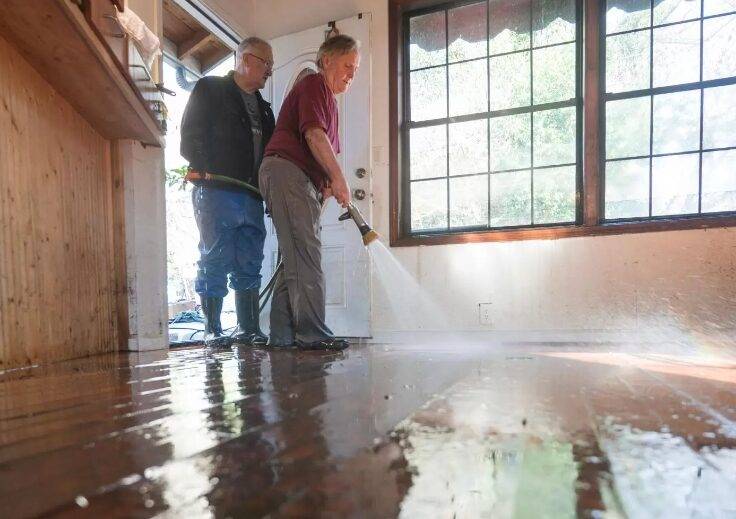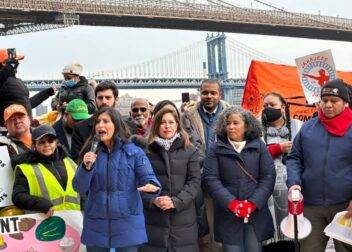Can insurance protect us from calamity?
With climate change causing an increase in extreme weather events, many people are finding themselves more susceptible to disasters and the financial hardship that can come with them. Certain governments, such as California, are taking steps to reduce carbon emissions and develop plans to protect citizens and infrastructure from these events.
Despite its lack of popularity, studies indicate that insurance can make a significant difference in whether individuals recover or face ruin following disasters, particularly for those who lack personal savings or do not meet the federal requirements to obtain loans.
According to Carolyn Kousky, an economist at the Environmental Defense Fund and author of the book “Understanding Disaster Insurance: New Tools for a More Resilient Future,” insurance can offer crucial financial support following a disaster. However, it is currently falling short for many individuals.

Gaps in insurance coverage
The cost of disaster insurance can be high, and it may not even be available in some cases. One reason for this is the design of traditional insurance, which is intended to spread risk among a group of policyholders to cover accidental events. For instance, if one out of a thousand customers experiences a burst pipe, there would be sufficient funds in the insurance pool to compensate for their losses.
When natural disasters such as hurricanes or wildfires devastate entire communities, it results in an enormous influx of claims all at once, and traditional insurance policies are not equipped to handle such situations. Insurance companies often face significant losses and even the risk of bankruptcy. Consequently, many insurance companies are now withdrawing from high-risk areas such as California, Florida, and Louisiana.
California, where this winter’s severe flooding has occurred, has a situation where 98% of homeowners don’t have flood insurance. This implies that the majority of affected individuals will have to rely on their own savings, loans (if they are eligible), and a small amount of money from the Federal Emergency Management Agency to recover from the disaster.
This situation can be particularly challenging for lower-income families who may not have the financial means to wait for FEMA aid or have the necessary resources to navigate the application and inspection process. Moreover, several studies have highlighted that FEMA assistance is often unequally distributed, favoring white, more affluent households who can wait for the aid and meet the application requirements.
“Disaster recovery can be quite harmful without insurance, resulting in individuals depleting their retirement savings, failing to pay their bills, or ceasing to invest in healthcare,” say Kousky.
Across the country, not just in drought-prone California, many people remain uninsured against floods. Approximately 70% of homes in high-risk areas, as designated by FEMA flood maps, do not have flood insurance. These maps are believed to underestimate flood risk since they do not account for climate change or inland flooding caused by heavy rainfall.
Parametric insurance: a new model
Kousky and her team are working to make insurance more accessible to everyone. They have developed a pilot project in partnership with the New York City Mayor’s Office of Climate and Environmental Justice, Center for NYC Neighborhoods, and SBP, a national nonprofit for disaster recovery. The project aims to show how insurance can be redesigned to reach a wider audience at a lower cost, giving everyone an equal chance to recover from disasters.
The project employs a type of insurance that is not commonly used in the United States. Parametric insurance, which is more prevalent in less developed nations, offers quick cash payouts right after a disaster, without the need for paperwork or a claims adjuster visit. The payouts are triggered automatically by a measurable event, such as wind speed or flood water levels.
The Center for NYC Neighborhoods is utilizing a parametric insurance policy in the pilot program to fund an initiative that provides emergency cash grants following heavy rainfall-induced flooding, such as the flash floods that claimed the lives of 13 individuals in the city in 2021. Households that are covered may receive up to $10,000 within days if they are impacted.
A fast and immediate cash injection can be crucial in such situations. According to a report, nearly 30% of American households don’t have enough cash reserves to cover an unexpected $400 expense.
According to Kousky, disaster expenses often go beyond property damage. For instance, in case of a disaster, there could be situations like power outages where one might require a generator, or the transit could be flooded, and one might lose income due to being unable to reach work, or schools could close down and result in the need for child care. Traditional insurance primarily focuses on protecting property, but it doesn’t always cater to the practical problems that people face in their everyday lives. She explains:
“It’s a very new concept, so we will continue to learn and make adjustments.”
Her goal is to make it a useful resource for safeguarding lower-income communities. Several cities in California and South Carolina have already shown interest.
Where parametric insurance is used
Parametric insurance products aren’t just limited to individuals. In the Caribbean, entire countries have invested in disaster coverage provided by parametric insurance products. These products were created after frustrations with slow and ineffective international aid.
Following Hurricane Sandy, the New York City Metropolitan Transit Authority established a parametric catastrophe bond, which provides payouts if storm surges reach levels that could potentially flood subway tunnels.
Jumpstart insurance, which is triggered by an earthquake, is available for anyone in California to purchase. The insurance product is parametric, meaning that payouts are confirmed by simply responding “yes” to a geotargeted text message.
Flood Flash is a UK-based insurance startup that utilizes flood sensors installed on clients’ buildings to initiate claims and can disburse payments within a few hours. The firm is planning to expand its services to the United States by introducing parametric policies for businesses located in California, Florida, Louisiana, Texas, and Virginia.
Reducing climate risk
Insurance reform offers another fascinating prospect: damage prevention. For instance, in Kenya, cattle farmers can obtain parametric payouts when the initial signs of drought emerge to enable them to stock up on feed. In Canada, 15 major insurance firms are collaborating with Ducks Unlimited to invest in wetlands protection to minimize flooding.
EDF has partnered with a prominent commercial insurance company in the US to explore the use of insurance as a tool to mitigate climate risk. One strategy could involve insurers incentivizing oil and gas companies to reduce their methane emissions, which are known to accelerate climate change, by requiring them to meet specific emissions control standards in order to qualify for coverage.
According to Kousky, relying solely on insurance is not a solution for a society that disregards the dangers posed by climate change. She believes that it is crucial to consider building codes, land use, and post-disaster construction methods. She emphasizes:
“Simply altering the insurance system won’t solve the problem. We must mitigate the risk.”



